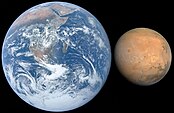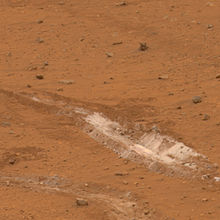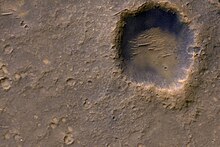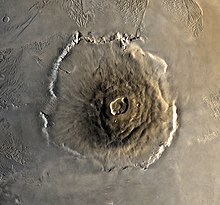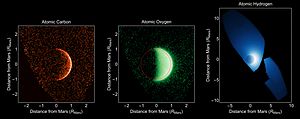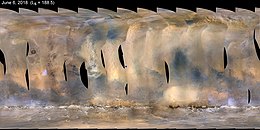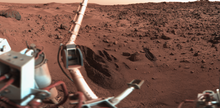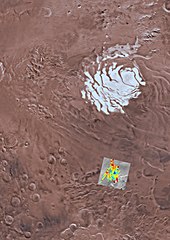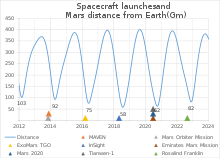Elon Musk and SpaceX have proposed the development of Mars transportation infrastructure in order to facilitate the eventual colonization of Mars. The design includes fully reusable launch vehicles, human-rated spacecraft, on-orbit propellant tankers, rapid-turnaround launch/landing mounts, and local production of rocket fuel on Mars via in situ resource utilization (ISRU). SpaceX's aspirational goal is to land the first humans on Mars by 2024.
The key element of the infrastructure is the BFR, a two-stage rocket where the upper stage is also used as spacecraft to reach Mars and to return to Earth. To achieve a large payload, the spacecraft first enters Earth orbit, where it is refuelled before it departs to Mars. After landing on Mars, the spacecraft is loaded with locally produced fuel to return to Earth. The expected payload of BFR is 150 tonnes (330,000 lb) to Mars.
SpaceX intends to concentrate its resources on the transportation part of the Mars colonization project, including the design of a Sabatier propellant plant that will be deployed on Mars to synthesize methane and liquid oxygen as rocket propellants from the local supply of atmospheric carbon dioxide and ground-accessible water ice. However, Musk advocates a larger set of long-term Mars settlement objectives, going far beyond what SpaceX projects to build; a successful colonization would ultimately involve many more economic actors—whether individuals, companies, or governments—to facilitate the growth of the human presence on Mars over many decades.
The key element of the infrastructure is the BFR, a two-stage rocket where the upper stage is also used as spacecraft to reach Mars and to return to Earth. To achieve a large payload, the spacecraft first enters Earth orbit, where it is refuelled before it departs to Mars. After landing on Mars, the spacecraft is loaded with locally produced fuel to return to Earth. The expected payload of BFR is 150 tonnes (330,000 lb) to Mars.
SpaceX intends to concentrate its resources on the transportation part of the Mars colonization project, including the design of a Sabatier propellant plant that will be deployed on Mars to synthesize methane and liquid oxygen as rocket propellants from the local supply of atmospheric carbon dioxide and ground-accessible water ice. However, Musk advocates a larger set of long-term Mars settlement objectives, going far beyond what SpaceX projects to build; a successful colonization would ultimately involve many more economic actors—whether individuals, companies, or governments—to facilitate the growth of the human presence on Mars over many decades.
History
As early as 2007, Elon Musk stated a personal goal of eventually enabling human exploration and settlement of Mars, although his personal public interest in Mars goes back at least to 2001.
Bits of additional information about the mission architecture were
released in 2011–2015, including a 2014 statement that initial colonists
would arrive at Mars no earlier than the middle of the 2020s.
Company plans in mid-2016 continued to call for the arrival of the first humans on Mars no earlier than 2025.
Musk stated in a 2011 interview that he hoped to send humans to Mars's surface within 10–20 years,
and in late 2012 he stated that he envisioned a Mars colony of tens of
thousands with the first colonists arriving no earlier than the middle
of the 2020s.
Development work began in earnest before 2012 when SpaceX started to design the Raptor rocket engine
which will propel all versions of the BFR launch vehicle and
spacecraft. Rocket engine development is one of the longest subprocesses
in the design of new rockets.
In October 2012, Musk articulated a high-level plan to build a
second reusable rocket system with capabilities substantially beyond the
Falcon 9/Falcon Heavy launch vehicles on which SpaceX had by then spent several billion US dollars.
This new vehicle was to be "an evolution of SpaceX's Falcon 9 booster
... much bigger [than Falcon 9]." But Musk indicated that SpaceX would
not be speaking publicly about it until 2013.
In June 2013, Musk stated that he intended to hold off any potential IPO of SpaceX shares on the stock market until after the "Mars Colonial Transporter is flying regularly."
In August 2014, media sources speculated that the initial flight test
of the Raptor-driven super-heavy launch vehicle could occur as early as
2020, in order to fully test the engines under orbital spaceflight
conditions; however, any colonization effort was reported to continue to
be "deep into the future".
In January 2015, Musk said that he hoped to release details in
late 2015 of the "completely new architecture" for the system that would
enable the colonization of Mars. But those plans changed and, by
December 2015, the plan to publicly release additional specifics had
moved to 2016.
In January 2016, Musk indicated that he hoped to describe the
architecture for the Mars missions with the next generation SpaceX
rocket and spacecraft later in 2016, at the 67th International Astronautical Congress conference, in September 2016.
Musk stated in June 2016 that the first unmanned MCT Mars flight was
planned for departure in 2022, to be followed by the first manned MCT
Mars flight departing in 2024.
By mid-September 2016, Musk noted that the MCT name would not continue,
as the system would be able to "go well beyond Mars", and that a new
name would be needed. This became the Interplanetary Transport System (ITS), a name that would, in the event, last for just one year.
On 27 September 2016, at the 67th annual meeting of the International Astronautical Congress,
Musk unveiled substantial details of the design for the transport
vehicles—including size, construction material, number and type of
engines, thrust, cargo and passenger payload capabilities, on-orbit
propellant-tanker refills, representative transit times, etc.—as well as
a few details of portions of the Mars-side and Earth-side
infrastructure that SpaceX intends to build to support the flight
vehicles. In addition, Musk championed a larger systemic vision, a vision for a bottom-up emergent order
of other interested parties—whether companies, individuals, or
governments—to utilize the new and radically lower-cost transport
infrastructure to build up a sustainable human civilization on Mars, potentially, on numerous other locations around the Solar System, by innovating and meeting the demand that such a growing venture would occasion. In the 2016 iteration, the system technology was specifically envisioned to eventually support exploration missions to other locations in the Solar System including the moons of Jupiter and Saturn.
In July 2017, SpaceX made public plans for ITS based on a smaller
launch vehicle and spacecraft. The new system architecture has "evolved
quite a bit" since the November 2016 articulation of the very large Interplanetary Transport System. A key driver of the new architecture is to make the new system useful for substantial Earth-orbit and cislunar launches so that the new system might pay for itself, in part, through economic spaceflight activities in the near-Earth space zone. The BFR is designed to fulfill the Mars transportation goals while also launching satellites, servicing the ISS, flying humans and cargo to the Moon, and enabling ballistic transport of passengers on Earth as a substitute to long-haul airline flights.
Musk indicated in November 2018 that "We've recently made a number of
breakthroughs [that I am] just really fired up about." and that, as a
result, he foresees a 70 percent probability that he personally would go
to Mars. He answered an interviewer's question that included a
presumption that "a Mars voyage could be an escape hatch for the rich"
by saying:
No. Your probability of dying on Mars is much higher than Earth. Really the ad for going to Mars would be like Shackleton’s ad for going to the Antarctic [in 1914]. It’s gonna be hard. There’s a good chance of death, going in a little can through deep space. You might land successfully. Once you land successfully, ... there's a good chance you'll die there. We think you can come back; but we're not sure.
Description
Interplanetary Spaceship departing Earth, passing the Moon.
SpaceX's Mars objectives, and the specific mission architectures and
launch vehicle designs that might be able to participate in parts of
that architecture, have varied over the years, and only partial
information has been publicly released. However, once the architecture
was unveiled in late 2016, all launch vehicles, spacecraft, and ground
infrastructure have shared several basic elements.
Overview and major elements
The
SpaceX Mars architecture, first detailed publicly in 2016, consists of a
combination of several elements that are key—according to Musk—to
making long-duration beyond Earth orbit (BEO) spaceflights possible by reducing the cost per ton delivered to Mars.
Additional detail on the Mars transportation architecture was added by Musk in 2017:
- a new fully reusable super heavy-lift launch vehicle that consists of a reusable booster stage and a reusable integrated second-stage-with-spacecraft that comes in at least two versions: a large, long-duration, beyond-Earth-orbit spacecraft capable of carrying passengers, bulk cargo, or propellant cargo, to other Solar System destinations. The combination of a second-stage of a launch vehicle with a long-duration spacecraft is unusual for any space mission architecture, and has not been seen in previous spaceflight technology.
- refilling of propellants in orbit, specifically to enable the long-journey spacecraft to expend most all of its propellant load during the launch to low Earth orbit while it serves as the second stage of the launch vehicle, and then—after refilling on orbit—provide the significant amount of energy necessary to put the spacecraft onto an interplanetary trajectory.
- propellant production on the surface of Mars: to enable the return trip back to Earth and support reuse of the spacecraft, enabling significantly lower cost to transport cargo and passengers to distant destinations. Once again, the large propellant tanks in the integrated space vehicle are filled remotely.
- selection of the right propellant: Methane (CH4)/oxygen (O2)—also known as "deep cryo methalox"—was selected as it was considered better than other common space vehicle propellants like Kerolox or Hydrolox principally due to ease of production on Mars and the lower cost of the propellants on Earth when evaluated from an overall system optimization perspective. Methalox was considered equivalent to one of the other primary options in terms of vehicle reusability, on-orbit propellant transfer, and appropriateness for super-heavy vehicles.
Rocket technology development
SpaceX has articulated that a completely new, fully reusable, super heavy-lift launch vehicle
is needed, and is developing designs that consist of a reusable booster
stage and a reusable integrated second-stage/long-duration-spacecraft.
They have developed more than one comprehensive set of booster and
spacecraft designs that they believe would best achieve their Mars
vision.
The current vehicle designs, unveiled in September 2017, include
four vehicles that each use what Musk called the internal codename "BFR": the BFR booster, BFR spaceship, BFR tanker, and the BFR satellite delivery spacecraft.
Super-heavy lift launch vehicle
The 9 meters (30 ft)-diameter design released in September 2017 for the super-heavy lift launch vehicle
BFR was sized to place up to 150 tonnes (330,000 lb) (reusable-mode) or 250 tonnes (550,000 lb) (expendable-mode)—or carry 150 tonnes (330,000 lb) of propellant on a tanker—to low Earth orbit (LEO).
The 2016 design for the 12 meters (39 ft)-diameter ITS launch vehicle
was sized to place up to 300 tonnes (660,000 lb) (reusable-mode) or 550
tonnes (1,210,000 lb) (expendable-mode)—or carry 150 tonnes
(330,000 lb) of propellant on an ITS tanker—to LEO.
All parts of the SpaceX rocket architecture for Mars will be powered by the Raptor bipropellant liquid rocket engines on both stages, using exclusively densified liquid methane fuel and liquid oxygen oxidizer on both stages.
The tanks will be autogenously pressurized, eliminating the need for the problematic helium gas pressurization.
All parts of the launch vehicle design are fully reusable, making use of the SpaceX reusable technology that was developed during 2011–2017 for Falcon 9 and Falcon Heavy.
On all Earth-away launches, the long-duration spacecraft (whether
tanker, cargo ship, or spaceship) is planned to also play a role
briefly as the second stage of the launch vehicle to provide acceleration to orbital velocity, a design approach not used in other launch vehicles.
Passenger spaceship
The passenger spacecraft is an interplanetary-capable ship with a carbon-fiber primary structure propelled by Raptor engines operating on densified methane/oxygen propellants.
As of September 2017, the current design is known as the BFR spaceship and by October 2017, was slated to be powered by seven Raptor engines, the three center engines to be used for retropropulsive landing of the spaceship.
The 2016 design—termed the Interplanetary Spaceship—was
49.5 m (162 ft)-long, had a maximum hull diameter of 12 m, with a 17 m
(56 ft)-diameter at its widest point, was powered by nine Raptor
engines, and was projected to be capable of transporting up to 450
tonnes (990,000 lb) of cargo and passengers per trip to Mars, with
on-orbit propellant refill before the beyond-Earth-orbit part of the
journey.
Early flights to Mars are expected to carry mostly equipment and few people.
The transport capacity of the 2016 spaceship from low Earth orbit to a Mars trajectory—with a trans-Mars trajectory insertion energy gain
of 6 km/s (3.7 mi/s) and full propellant tanks—was projected to be 450
tonnes (500 tons) to Mars orbit, or 300 tonnes (330 tons) landed on the
surface with retropropulsive landing.
SpaceX estimated Earth-Mars transit times to vary between 80–150 days,
depending on particular planetary alignments during the nine discrete
2020–2037 mission opportunities, assuming 6 km/s delta-v added at trans-Mars injection.
Artist's rendering of an Interplanetary Spaceship entering the Martian atmosphere
The spaceship is designed to enter the Martian atmosphere at entry velocities in excess of 8.5 km/s and allow aerodynamic forces
to provide the major part of the deceleration before the three center
Raptor engines perform the final landing burn. The heat shield material
protecting the ship on descent is PICA 3.0, and is reusable. Entry g-forces at Mars are expected to be in order of 4–6 g during the descent.
The spaceship design g-load would be in the range of 5 g nominal, but
able to withstand peak loads 2 to 3 times higher without breaking up. Energy for the spaceship during the journey to Mars is projected to be produced by two large solar panel arrays, generating in the 2016 design approximately 200 kW of power
while at the distance of Earth from the Sun, and less as the journey
progresses and the Sun is farther away as the ship nears Mars. On Mars journeys, the spaceship may use a large internal water layer to help shield occupants from space radiation, and may have a cabin oxygen content that is up to two times that which is found in Earth's atmosphere. The initial tests of the spaceship are not expected prior to 2020, with the booster to follow only later.
According to Musk, once landed, the spaceship would effectively become the first human habitat on Mars.
Tanker and cargo spacecraft
A key feature of the overall launch system is a propellant-cargo-only tanker or cargo spacecraft: the BFR tanker or BFR satellite delivery spacecraft.
Just as for the spaceship, the tanker or cargo spacecraft serve as the
upper stage of the ITS launch vehicle during the launch from Earth.
The vehicle design for the tanker is exclusively for the launch and short-term holding of propellants to be transported to low Earth orbit for re-filling propellants in the spacecraft/ships. Once on orbit, a rendezvous operation will be effected with any ship that will be transiting on to a beyond Earth-orbit (BEO) destination, plumbing connections are made, and liquid methane and liquid oxygen
propellants are transferred to the spaceship. To fully fuel a BEO ship
for a long-duration flight, it is expected that several tankers would be
required to launch from Earth, carrying and transferring the propellant
to fully load for the longer, high-energy journey.
Following completion of the on-orbit propellant offloading, the concept of operations called for the reusable tanker to reenter Earth's atmosphere, land, and be prepared for another tanker flight.
The tankers and cargo ships are planned to be the same physical dimensions as the passenger spaceship.
Propellant plant on Mars
A
key part of the Mars system architecture that Musk conceptualized in
order to radically decrease the cost of spaceflight to
beyond-Earth-orbit destinations is the placement and operation of a
physical plant on Mars to handle in situ production and storage
of the propellant components necessary to launch and fly the cargo and
passenger spaceships back to Earth, or perhaps to increase the mass that
can be transported onward to destinations in the outer Solar System.
Coupled with the Earth-orbit tank filling prior to the journey to Mars,
and the fully reusable launch vehicles and spacecraft, all three
elements are needed to reduce the transport cost by the multiple orders
of magnitude that Musk sees as necessary to support sustainable
colonization of Mars.
The first cargo spaceship to transit to Mars was projected to
carry a small propellant plant as a part of its cargo load. The plant is
expected to be expanded over multiple synods as more equipment arrives, is installed, and placed into mostly autonomous production.
The propellant plant intends to take advantage of the large supplies of carbon dioxide and water resources on Mars, mining the water (H2O) from subsurface ice and collecting CO2 from the atmosphere. A chemical plant will process the raw materials by means of electrolysis and the Sabatier process to produce molecular oxygen (O2) and methane (CH4), and then liquefy it to facilitate long-term storage and ultimate use.
Analysis of a Mars-based chemical plant based on Earth-constructed
pressurized modules that fit whole into the cargo hold of an ITS cargo
ship, analogous to shipping containers, has been proposed to initiate a chemical industry on Mars.
Launch site
As
of September 2017, the SpaceX next-generation launch vehicle, BFR, will
be used to replace all existing SpaceX launch vehicles—Falcon 9 and Falcon Heavy—as well as the Dragon spacecraft, and that is the launch vehicle that will be used to support the SpaceX Mars space transport architecture. The SpaceX leased launch facility at LC-39A will be used to launch BFR.
When their earlier concept, then-named "Mars Colonial
Transporter," was initially discussed in March 2014, no launch site had
yet been selected for the super-heavy lift rocket and SpaceX indicated
at the time that their leased facility at historic Launch Pad 39A
would not be large enough to accommodate the vehicle as it was
understood conceptually in 2014, and that therefore a new site would
need to be built in order to launch the >10-meter diameter rocket. However, it was later revealed that the optimized size of the Raptor engine would be fairly close to the physical size of the Merlin 1D (although each engine will have approximately three times the thrust), allowing the use of LC-39A for BFR.
During a groundbreaking ceremony for the SpaceX South Texas Launch Site in September 2014, Elon Musk mused that the first person to go to another planet could possibly launch from Texas,
but did not indicate at the time what launch vehicle might be used to
carry humans to orbit. Musk stated in September 2016 that the launch
vehicle may launch from more than one site.
Mission concepts
Mars early missions
Musk
has indicated that the earliest SpaceX-sponsored missions would have a
smaller crew and use much of the pressurized space for cargo.
As envisioned in 2016, the first crewed Mars missions might be
expected to have approximately 12 people, with the primary goal to
"build out and troubleshoot the propellant plant and Mars Base Alpha
power system" as well as a "rudimentary base." In the event of an
emergency, the spaceship would be able to return to Earth without having
to wait a full 26 months for the next synodic period.
Before any people are transported to Mars, some number of cargo
missions would be undertaken first in order to transport the requisite equipment, habitats and supplies.
Equipment that would accompany the early groups would include "machines
to produce fertilizer, methane and oxygen from Mars' atmospheric
nitrogen and carbon dioxide and the planet's subsurface water ice" as
well as construction materials to build transparent domes for crop
growth.
The early concepts for "green living space" habitats include glass panes with a carbon-fiber-frame geodesic domes, and "a lot of miner/tunneling droids
[for building] out a huge amount of pressurized space for industrial
operations." But these are merely conceptual and not a detailed design
plan.
Mars settlement concept
As of 2016 when publicly discussed, SpaceX the company is concentrating its resources on the transportation part of the overall Mars architecture project as well as an autonomous propellant plant
that could be deployed on Mars to produce methane and oxygen rocket
propellants from local resources. If built, and if planned objectives
are achieved, then the transport cost of getting material and people to
space, and across the inner Solar System, will be reduced by several orders of magnitude. SpaceX CEO Elon Musk
is championing a much larger set of long-term Mars settlement
objectives, ones that take advantage of these lower transport costs to
go far beyond what the SpaceX company will build and that will
ultimately involve many more economic actors—whether individual, company, or government—to build out the settlement over many decades.
In addition to explicit SpaceX plans and concepts for a
transportation system and early missions, Musk has personally been a
very public exponent of a large systemic vision for building a
sustainable human presence on Mars over the very long term, a vision
well beyond what his company or he personally can effect. The growth of
such a system over decades cannot be planned in every detail, but is
rather a complex adaptive system
that will come about only as others make their own independent choices
as to how they might, or might not, connect with the broader "system" of
an incipient (and later, growing) Mars settlement. Musk sees the new
and radically lower-cost transport infrastructure facilitating the
buildup of a bottom-up economic order of other interested parties—whether companies, individuals, or governments—who will innovate and supply the demand that such a growing venture would occasion.
While the initial SpaceX Mars settlement would start very small, with an initial group of about a dozen people,
with time, Musk hopes that such an outpost would grow into something
much larger and become self-sustaining, at least 1 million people.
According to Musk,
Even at a million people you’re assuming an incredible amount of productivity per person, because you would need to recreate the entire industrial base on Mars. You would need to mine and refine all of these different materials, in a much more difficult environment than Earth. There would be no trees growing. There would be no oxygen or nitrogen that are just there. No oil.
Excluding organic growth, if you could take 100 people at a time, you would need 10,000 trips to get to a million people. But you would also need a lot of cargo to support those people. In fact, your cargo to person ratio is going to be quite high. It would probably be 10 cargo trips for every human trip, so more like 100,000 trips. And we’re talking 100,000 trips of a giant spaceship.
The notional journeys outlined in the November 2016 talk would require 80 to 150 days of transit time, with an average trip time to Mars of approximately 115 days (for the nine synodic periods occurring between 2020 and 2037). In 2012, Musk stated an aspirational price goal for such a trip might be on the order of US$500,000 per person, but in 2016 he mentioned that long-term costs might become as low as US$200,000.
As of September 2016, the complex project has financial commitments only from SpaceX and Musk's personal capital. The Washington Post
pointed out that "The [US] government doesn't have the budget for Mars
colonization. Thus, the private sector would have to see Mars as an
attractive business environment. Musk is willing to pour his wealth into
the project" but it will not be enough to build the colony he
envisions.
Outer planet concepts
Artist's impression of the Interplanetary Spaceship over Saturn.
The overview presentation on the Mars architecture given by Musk in
September 2016 included concept slides outlining missions to the Saturnian moon Enceladus, the Jovian moon Europa, Kuiper belt objects, a fuel depot on Pluto and even the uses to take payloads to the Oort Cloud.
"Musk said ... the system can open up the entire Solar System to
people. If fuel depots based on this design were put on asteroids or
other areas around the Solar System, people could go anywhere they
wanted just by planet or moon hopping. 'The goal of SpaceX is to build
the transport system ... Once that transport system is built, then there
is a tremendous opportunity for anyone that wants to go to Mars to
create something new or build a new planet.'" Outer planet trips would likely require propellant refills at Mars, and perhaps other locations in the outer Solar System. Plans for the 2018 BFR reiterated the idea of using it for missions to outer planets.
Funding
The extensive development and manufacture of much of the space transport technology has been through 2016, and is being privately funded
by SpaceX. The entire project is even possible only as a result of
SpaceX multi-faceted approach focusing on the reduction of launch costs.
As of October 2016, SpaceX was expending "a few tens of millions
of dollars annually on development of the Mars transport concept, which
amounts to well under 5 percent of the company’s total expenses", but expects that figure to rise to some US$300 million per year by around 2018. The cost of all work leading up to the first Mars launch was expected to be "on the order of US$10 billion" and SpaceX expected to expend that much before it generates any transport revenue.
No public update of total costs before revenue was given in 2017 after
SpaceX redirected to the small launch vehicle design of the BFR.
Musk indicated in September 2016 that the full build-out of the Mars colonialization plans would likely be funded by both private and public funds. The speed of commercially available Mars transport for both cargo and humans will be driven, in large part, by market demand as well as constrained by the technology development and development funding.
In October 2017, he reiterated that "the actual establishment of a base
was something that would be handled largely by other companies and
organizations. ... 'Our goal is get you there and ensure the basic
infrastructure for propellant production and survival is in place', he
said, comparing the BFR to the transcontinental railways of the 19th
century. 'A vast amount of industry will need to be built on Mars by
many other companies and millions of people'.
In 2016, Elon Musk stated that there is no expectation of
receiving NASA contracts for any of the Mars architecture system work,
but affirmed that such contracts would be good.
SpaceX tentative calendar for Mars missions
In
2016 SpaceX announced that there would be a number of early missions to
Mars prior to the first trip of the new large composite-structure
spacecraft. The early missions are planned to collect essential data to
refine the design, and better select landing locations based on the
availability of extraterrestrial resources such as water and building
materials.
2016 plans
In 2016, SpaceX announced plans to fly its earliest missions to Mars using its Falcon Heavy launch vehicle prior to the completion, and first launch, of any ITS vehicle. Later missions utilizing this technology—the ITS launch vehicle and Interplanetary Spaceship with on-orbit propellant refill via ITS tanker—were to begin no earlier than 2022. At the time, the company was planning for launches of research spacecraft to Mars using Falcon Heavy launch vehicles and specialized modified Dragon
spacecraft, called "Red Dragon". Due to planetary alignment in the
inner Solar System, Mars launches are typically limited to a window of
approximately every 26 months. As announced in June 2016, the first
launch was planned for Spring 2018, with an announced intent to launch
again in every Mars launch window thereafter. In February 2017, however, the first launch to Mars was pushed back to 2020,[53] and in July 2017, SpaceX announced it would not be using a propulsively-landed "Red Dragon" spacecraft at all for the early missions, as had been previously announced.
The tentative mission manifest from November 2016 included three
Falcon Heavy missions to Mars prior to the first possible flight of an
ITS to Mars in 2022:
- 2018: initial SpaceX Mars mission: the Red Dragon, a modified Dragon 2 spacecraft launched by Falcon Heavy launch vehicle.
- 2020: second preparatory mission: at least two Red Dragons to be injected into Mars transfer orbit via Falcon Heavy launches
- 2022: third uncrewed preparatory mission: first use of the entire ITS system to put a spacecraft on an interplanetary trajectory and carry heavy equipment to Mars, notably a local power plant.
- 2024: first crewed ITS flight to Mars according to the "optimistic" schedule Musk discussed in October 2016, with "about a dozen people".
2017 revisions
In February 2017, public statements were made that the first Red Dragon
launch would be postponed to 2020. It was unclear at that time whether
the overall sequence of Mars missions would be kept intact and simply
pushed back by 26 months. In July 2017, Musk announced that development
of propulsive landing for the Red Dragon lander capsule was cancelled in favor of a "much better" landing technique, as yet unrevealed, for a larger spacecraft.
A 9 m (30 ft)-diameter BFR
rocket design, using the same Raptor engine technology and carbon-fiber
composite materials of the earlier ITS, was unveiled at International Astronautical Congress on 29 September 2017.
It is similar to the ITS design, but smaller. Musk announced additional
capabilities for the BFR, including Earth missions that could shuttle
people across the planet in under an hour (most flights would be less
than half an hour), Lunar missions, as well as Mars missions, that would
aim to land the first humans on the planet by 2024. SpaceX now plans to focus mainly on one launch vehicle for these missions - the BFR.
By focusing the company's efforts onto just a single launch vehicle,
the cost, according to Musk, can be brought down significantly. SpaceX also plans to use the BFR
for Earth-orbit missions, replacing all current SpaceX Falcon launch
vehicles. Construction of the first of the BFR vehicles would begin in
2018, according to Musk.




